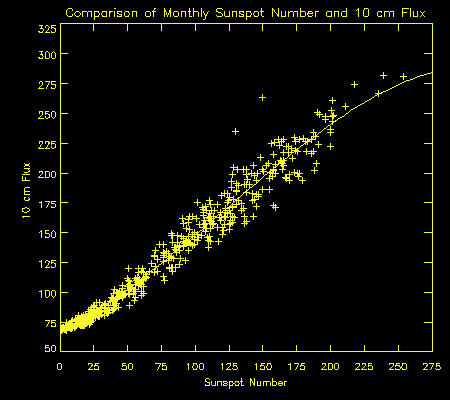The Ten Centimetre Solar Radio Flux
The radio emission from the Sun at a wavelength of 10.7 centimetres (often called "the 10 cm flux") has been found to correlate well with the sunspot number. Sunspot number is defined from counts of the number of individual sunspots as well as the number of sunspot groups and must be reduced to a standard scale taking into account the differences in equipment and techniques between observatories. On the other hand, the radio flux at 10.7 centimetres can be measured relatively easily and quickly and has replaced the sunspot number as an index of solar activity for many purposes.
The 10 cm flux can be used as a daily index or averaged over longer periods to trace out the trends in solar activity. Typically the 10 cm flux is averaged over a month or a year although sometimes a 90 day average is made.
Even though 10 cm flux and sunspot number both indicate activity they have quite different scales. This is evident in the figure where the 10 cm flux never drops below a value of approximately 67 even during solar minimum when the sunspot number is very close to zero.
The figure is a plot of the monthly-averaged sunspot number against the monthly-averaged 10 centimetre solar flux for data between 1947 and 1990. The correlation between these quantities is evident but there is still considerable scatter even for monthly-averaged values.
The following equations are useful for converting between 10 cm flux (F) and sunspot number (R). The equations are valid on a statistical (ie, average) basis.
F = 67.0 + 0.572 R + (0.0575 R)2 - (0.0209 R)3
R = 1.61 FD - (0.0733 FD)2 + (0.0240 FD)3
where FD = F - 67.0

Material prepared by Richard Thompson




